Need a safe, natural mouse repellent? Pick up one of these editor-tested products to keep mice away.
Our editors and experts handpick every product we feature. We may earn a commission from your purchases.Learn more.


Need a safe, natural mouse repellent? Pick up one of these editor-tested products to keep mice away.
Our editors and experts handpick every product we feature. We may earn a commission from your purchases.Learn more.
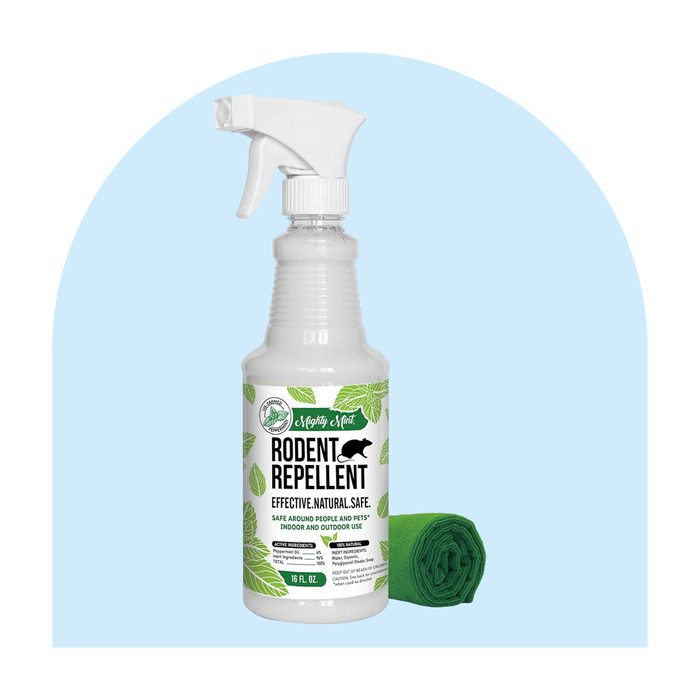
Pros:
Cons:
If you’re looking for an all-natural solution that’s safe to use around kids, this rodent-repellent spray from Mighty Mint is the answer. It comes in an easy-to-use 16-ounce spray bottle and uses pure peppermint oil to deter mice.
This spray has a 4% peppermint oil (not artificial mixtures that just smell like peppermint) concentration that makes it stronger than similar peppermint sprays, so it’s more effective and lasts longer.
The minty smell won’t leave a chemical-like odor in the air, and while the peppermint smell isn’t unpleasant, it is powerful. The first time I used this Mighty Mint spray, I used too much in an open space and had to air out my kitchen afterward. However, I found that using it in covered and concealed areas (like underneath the kitchen sink) works best, as the smell stays where you need it to.
If you have pets, consider skipping this one because peppermint oil can be toxic to cats and dogs when ingested.
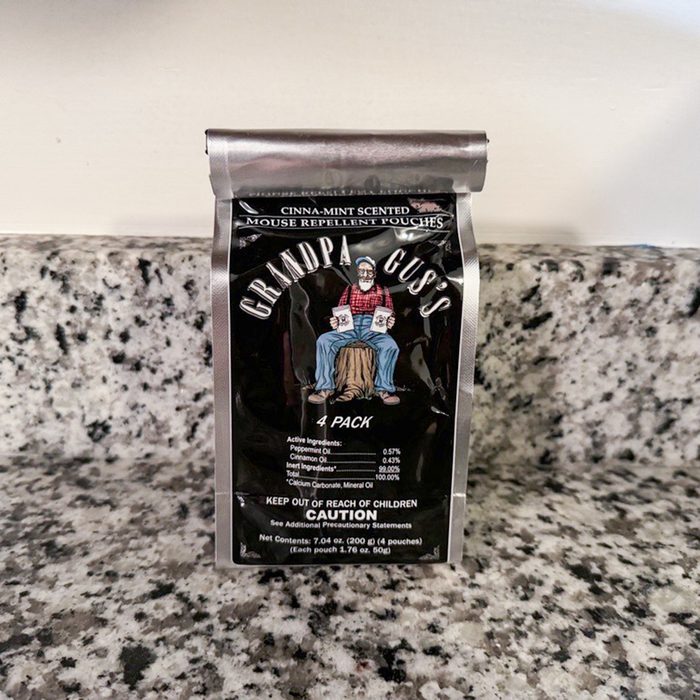
Pros:
Cons:
Hang ’em and forget ’em! These mouse-repellent pouches from Grandpa Gus’s are simple to use—just hang them up (or place them) wherever you want to prevent mice from feeling at home.
I like to use these peppermint and cinnamon-scented pouches in drawers and cabinets as an added line of defense against rodents, and I don’t find the smell to be overpowering at all.
Each pouch covers 50 square feet of space. They release a pleasant, mostly cinnamon scent that keeps the pests away for up to three months, and they’re also great for sheds, boats, RVs, and cars, as they don’t use harsh chemicals or toxic poison to repel rodents.
Again, if you have cats or dogs, use caution with this mouse repellent. If your curious pets might get into this product and lick or ingest it, the peppermint oil component can be toxic.
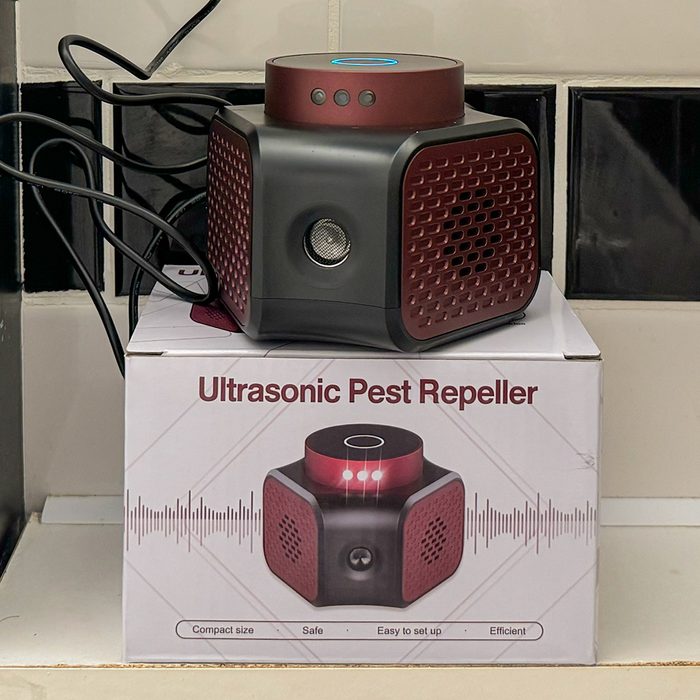
Pros:
Cons:
This ultrasonic pest repellent is powerful enough to cover 1,076 square feet, so your basement will be safe from various creatures. The device takes up about as much space as a coffee mug, and I like to put one in the back of the closet that houses my heating and cooling system (where mice are frequently found). I also like that the device works to repel spiders, too.
Although you won’t be able to detect the frequencies, the unit emits ultrasonic sounds and uses nine light-emitting diode (LED) strobe lights to disturb a rodent’s activity in a dark environment. The type of sound the machine produces also regularly changes, so mice and other pests won’t become accustomed to the noise.
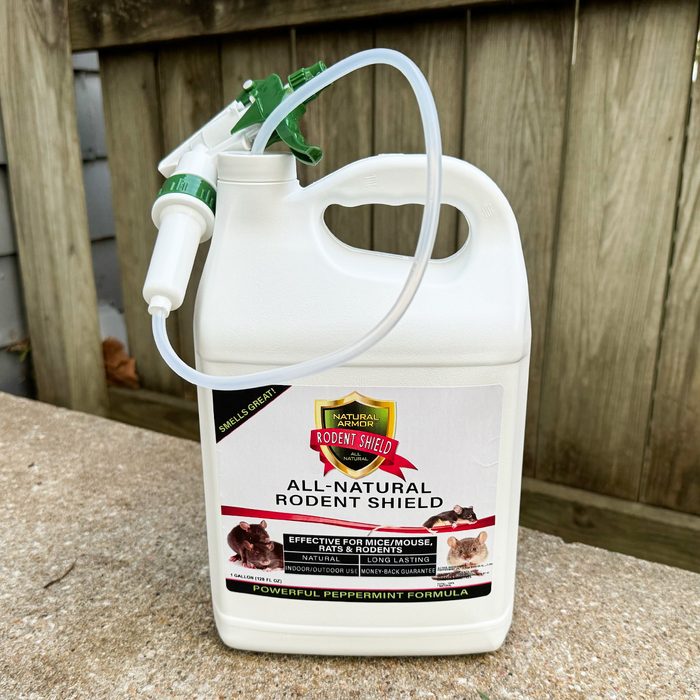
Pros:
Cons:
In addition to filling any holes around the outside of your home where mice can get in, you may also want to spray repellent outside to further deter mice. And if you don’t want plants and kids to come in contact with poison, then this all-natural rodent shield is the way to go.
The one-gallon size and convenient sprayer nozzle make Natural Armor’s rodent repellent fitting for outdoor use, like covering the entry points of your home or keeping mice out of your cabin and shed when you’re not around.
You can also use this spray indoors to spray your attic and basement. Its peppermint formula is safe for children, and it doesn’t harm the environment. Take caution if you have pets who go outdoors and might ingest this product, as peppermint essential oil is considered to be toxic to dogs and cats.
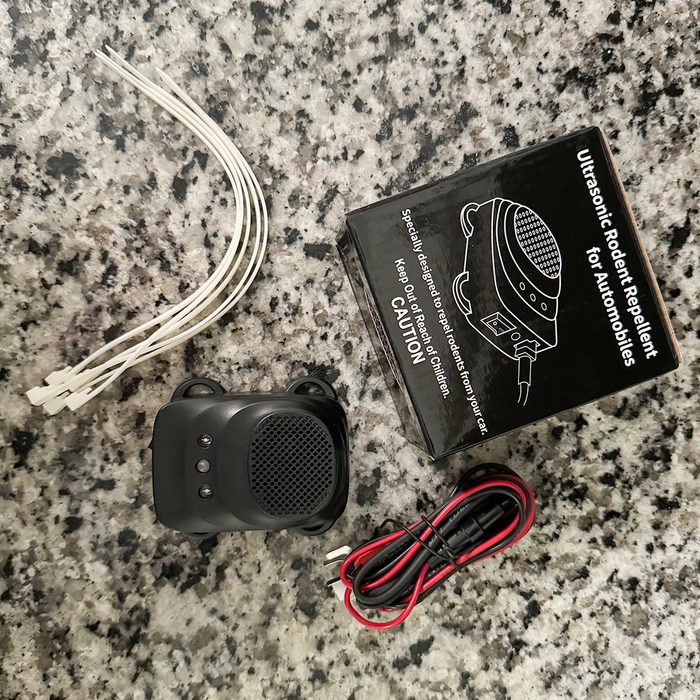
Pros:
Cons:
If you’re worried about rodents getting into your vehicle and disturbing wiring and cables, then an under-hood rodent repellent device can be used as an added deterrent.
Designed to be placed under the hood of a car, this rodent-repellent device uses ultrasonic noise and bright LED strobe lights to dissuade critters that might chew through electrical wiring and cables. Your car battery powers the machine and automatically shuts off when you start the car—then powers back on when you park.

Pros:
Cons:
You’ll have all the mouse repellent power you need with this six-pack of ultrasonic repellent devices. Each unit covers up to nearly 400 square feet. The devices use ultrasonic waves to irritate pests and disturb their nervous systems, convincing them to move along and, hopefully, preventing them from taking up residency in your home.
Keep in mind, however, that ultrasonic waves can’t penetrate walls and solid objects, so it’s best to place one in each room you’re having the mice problem. Also, since the devices make pests uncomfortable, mice leave their safe spaces. So, keep in mind that you might see more of them in the beginning before they pack up and ship out.

“Repellents are a good part of any pest management strategy,” says Ed Dolshun, VP of Business Development and Technical Director at Catchmaster. “Ensure that any cracks or holes in your foundation are sealed, keep a clean home, and eliminate any stray food sources alongside using your repellants.”
When choosing a mouse repellent, consider the type that best suits your environment and needs. Here are the main types available:
Mouse repellents are typically safer than traps and poisons, making them a solid first line of defense against infestations. “Mice repellents are essential if you have encountered these rodents in your home,” Carpenter says. “They play a crucial role in preventing the spread of mouse-borne diseases and reducing allergenic substances left behind by these rodents.” Repellents are also a more environmentally friendly option than traps and poisons.
This is especially relevant with ultrasonic mouse repellents. While evidence of their effectiveness varies, particularly when a reliable food source is present, combining them with other repellents can boost their success. In short, the more strategies you employ to deter mice, the better your results will be.
Natural methods can work, but they need more frequent application to remain effective. “Peppermint, clove oil, lemon oil and eucalyptus oil are all known to be scents that mice can’t stand,” Dolshun says.
“Cayenne pepper’s stinging sensation makes it effective; sprinkle it where mice hide. Tabasco sauce, disliked by mice, should be applied around the exterior of your home,” Carpenter says. “The smell of peppermint deters mice and leaves your home smelling fresh.”
Unfortunately, house mice are common where I live, and they can cause damage and illness if allowed to settle in. Speaking from experience, it’s best to stay proactive about rodent issues—no one wants to wake up to a mouse running across the kitchen while making coffee.
For this list of rodent repellents, I tested each product in my home to evaluate ease of use, whether they were unpleasant for humans and pets and how well they performed. We also reviewed feedback from other users to ensure accuracy. We’re confident these are the best mouse repellents for safe use around your home.
An ultrasonic mouse repellent typically has an effective lifespan of three to five years. Since these devices rely on a constant power source, they will stop working if the power goes out or the batteries run out, so ensure they’re consistently powered for continued effectiveness.
Natural repellents can be just as effective as electronic ones, depending on the situation. They rely on rodents’ aversion to certain scents and chemicals but require more frequent reapplication. In desperate situations—like when food is scarce—mice might ignore these repellents, so it’s important to use them as part of a comprehensive pest control strategy.
Chemical repellents can be safe if placed in areas entirely inaccessible to pets. However, if there’s a chance that your pets might reach them, chemical repellents can be dangerous or even deadly if ingested. If you can’t keep your pets away from treated areas, using safer alternatives like natural or ultrasonic repellents is best. If you plan to use an essential oil-based repellent and you have pets, research toxicity for cats and dogs before buying. Natural doesn’t always mean safe, especially for our furry friends.
As someone living in the Great Plains, where house mice are a common issue, I (Mary Henn) tested the mouse repellents listed in my own home—where, unfortunately, I’ve encountered mice before. With my pest control experience and role as a shopping editor for Family Handyman, I’ve personally tested hundreds of home products across various categories, including pest control. My work has also been featured in trusted publications like Taste of Home, Reader’s Digest, MSN, NewsBreak and more.
We also consulted two pest control experts for this piece. The first, Nicole Carpenter, is a pest control expert at Black Pest Prevention. She takes great pride in being the fourth generation at Black Pest Prevention and strives to build upon what her great-grandfather and her uncle worked so hard to achieve. The second, Ed Dolshun, is the VP of Business Development and Technical Director at Catchmaster. In his role, Ed is responsible for both the development of new products as well as validation of existing products. Ed has over 12 years of experience in the pest management industry.
Sean Tirman, Content Updates Editor at Family Handyman, updated and contributed research to this piece. Sean has written shopping guides since 2016 and is a former associate editor at Gear Patrol.